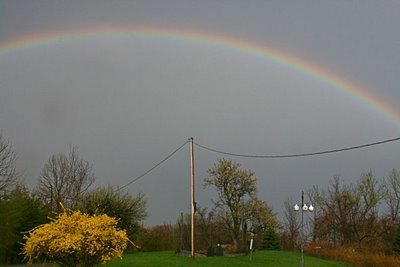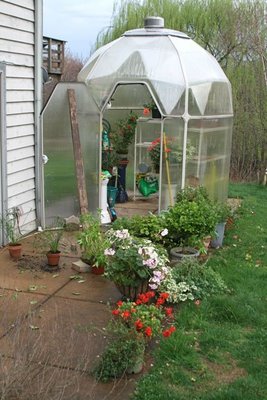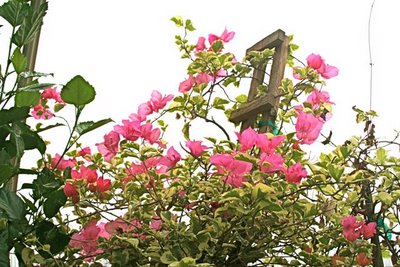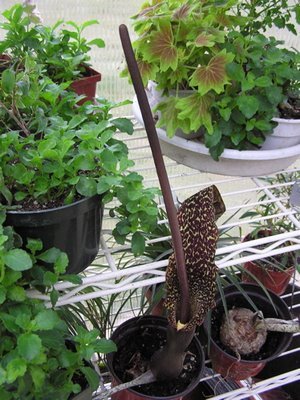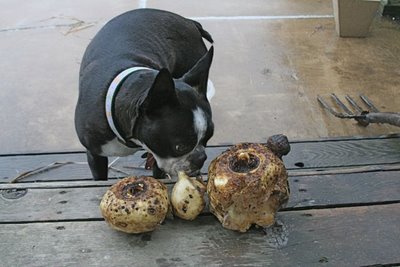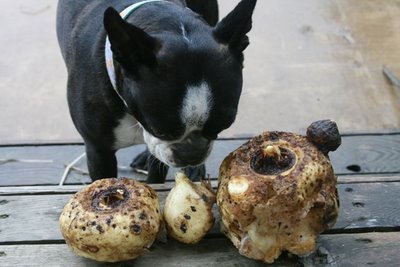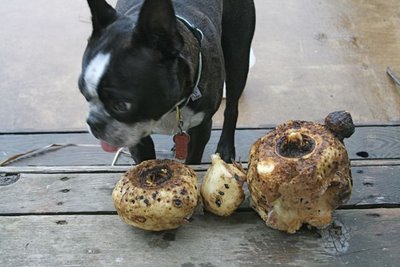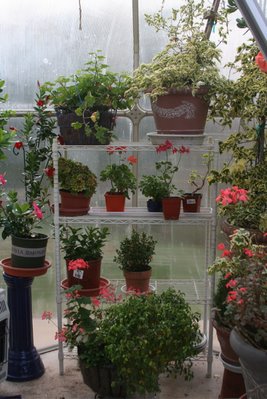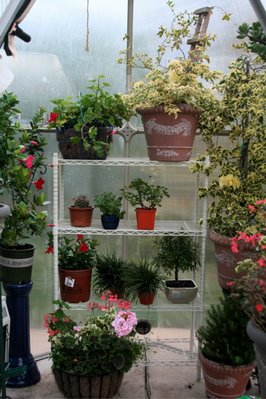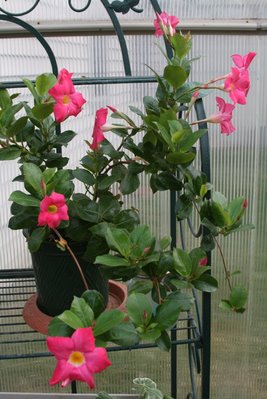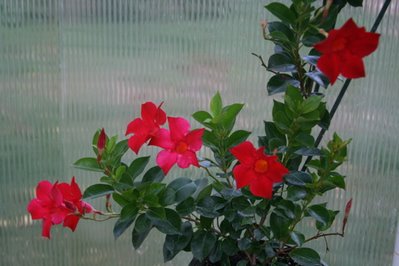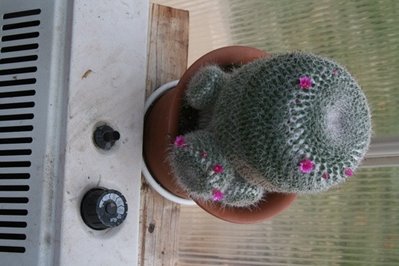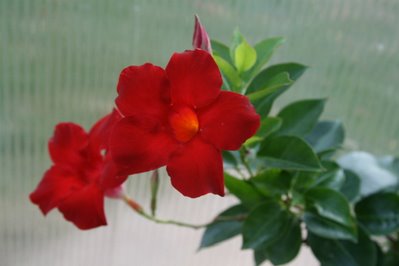Gardening With Exotic Plants
It occurred to me, looking at my photos, that pretty much everything I shot this morning was an exotic plant. Collective gasp. I've got natives, and I've got exotics, and I don't get my panties in a bunch about being true to one or the other. I go for pretty and useful, fragrant and beautiful, and as long as it doesn't take over, and it's one or more of those attributes, it gets a place in my garden.
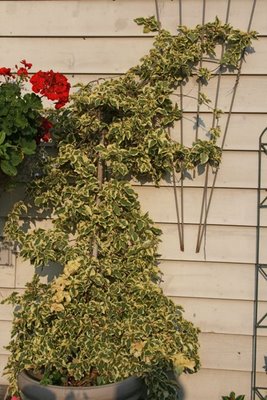
One: They will drop all their leaves if a cold draft blows into the greenhouse.
Two: They will grow more if you wait around.
Three: They will only bloom in the greenhouse, starting in January, and they quit blooming the minute I bring them outdoors in May. That has to be OK with me.
Four: They love a lot of food, and their favorite is Jobe's Plant Spikes. You can't give them too many Jobe's.
Five: They love water, too.
Six: I love these plants, though they are a bit fussy; I have two and they are both enormous, and they remind me of Mexico, and thinking about Mexico makes me happy. Especially in January.
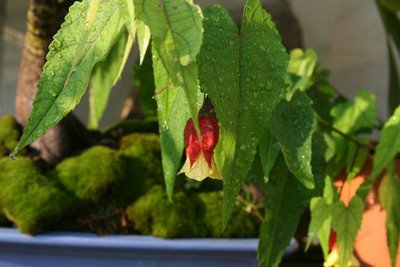 This is a funny little abutilon, or flowering maple, from Africa, whose name is Abutilon megapotamicum. I got it as a cutting from a friend many years ago. The rabbits ate it down to stubs twice this spring, and this is its first bloom. I like the flower form. It's related to hibiscus, actually.
This is a funny little abutilon, or flowering maple, from Africa, whose name is Abutilon megapotamicum. I got it as a cutting from a friend many years ago. The rabbits ate it down to stubs twice this spring, and this is its first bloom. I like the flower form. It's related to hibiscus, actually. Purple heliotrope is a year-round must for me. It smells like cherry vanilla candy. Mmmm. I can't pass it without stooping to sniff, which is why it's planted right on the edge of the raised bed. Gotta get those things up right under your nose or you miss what's wonderful about them.
Purple heliotrope is a year-round must for me. It smells like cherry vanilla candy. Mmmm. I can't pass it without stooping to sniff, which is why it's planted right on the edge of the raised bed. Gotta get those things up right under your nose or you miss what's wonderful about them.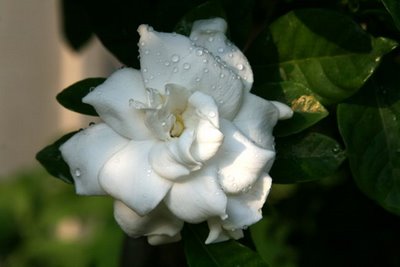 Speaking of sniffing, a gardenia opened this morning. Show me a more heavenly scent, a better-rounded, more complex earthly delight than the aroma of gardenias. I will plant the flower. Or I probably already am growing it. (Tuberoses are in bud!!)
Speaking of sniffing, a gardenia opened this morning. Show me a more heavenly scent, a better-rounded, more complex earthly delight than the aroma of gardenias. I will plant the flower. Or I probably already am growing it. (Tuberoses are in bud!!)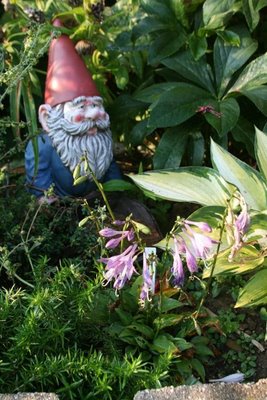 This little hosta, Baby Tears, is just going nuts this year. One-foot-tall gnome for scale. It's the smallest hosta I know, but knowing hosta freaks, they've come up with something tinier by now.
This little hosta, Baby Tears, is just going nuts this year. One-foot-tall gnome for scale. It's the smallest hosta I know, but knowing hosta freaks, they've come up with something tinier by now.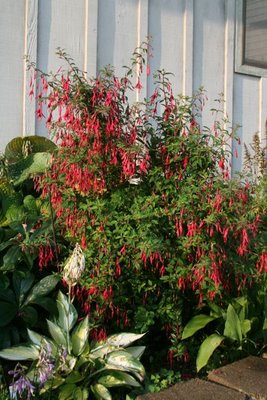 Speaking of going ape, here's Fuchsia magellenica, from southern South America. It's a perennial fuchsia and the hummingbirds love it when it finally gets going in late August. There's something utterly disarming about having a fuchsia come up after the snow melts, having lived through the winter, and throw out little red and purple ballerina flowers all summer.
Speaking of going ape, here's Fuchsia magellenica, from southern South America. It's a perennial fuchsia and the hummingbirds love it when it finally gets going in late August. There's something utterly disarming about having a fuchsia come up after the snow melts, having lived through the winter, and throw out little red and purple ballerina flowers all summer.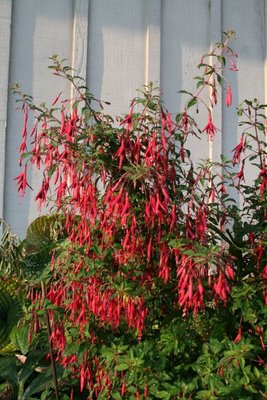 It's so vigorous this year, I'm wondering if it's planning to die, like the other three that used to be in this garden bed. I'll take some cuttings into the greenhouse this fall, just in case it has something up its sleeve. I've read that in California, this fuchsia can make a 6' high hedge!
It's so vigorous this year, I'm wondering if it's planning to die, like the other three that used to be in this garden bed. I'll take some cuttings into the greenhouse this fall, just in case it has something up its sleeve. I've read that in California, this fuchsia can make a 6' high hedge!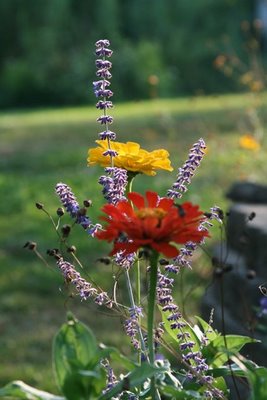 It wouldn't be a Zick garden without Russian sage and Mexican zinnias, mixing together in perfect exotic harmony. I've had to individually cage each zinnia I've planted this year, no thanks again to the rabbits. But oh, they're worth it.
It wouldn't be a Zick garden without Russian sage and Mexican zinnias, mixing together in perfect exotic harmony. I've had to individually cage each zinnia I've planted this year, no thanks again to the rabbits. But oh, they're worth it.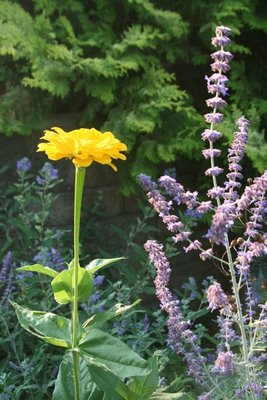 I hope you've enjoyed this little garden tour. How I'll miss them all when frost comes. I'm rolling in beauty right now. And we got three inches of rain thanks to the hurricane, so I won't have to water for a couple of weeks.
I hope you've enjoyed this little garden tour. How I'll miss them all when frost comes. I'm rolling in beauty right now. And we got three inches of rain thanks to the hurricane, so I won't have to water for a couple of weeks.I'm in constant motion these days, delivering and fetching kids, rehearsing for a Swinging Orangutangs gig on Sept. 5...we play 9-2...AM; taking lessons, taking kid to lessons; recording commentaries. I'm tired, and so are the kids--the first couple of weeks of school are murder. I guess we'll get used to getting up at 5:45 but it hasn't happened yet. Ahh, country life.
Labels: Abutilon megapotamicum, bougainvillea, exotic plants, Fuchsia magellenica, garden gnome, gardenia, heliotrope, hosta, Russian sage, zinnias

